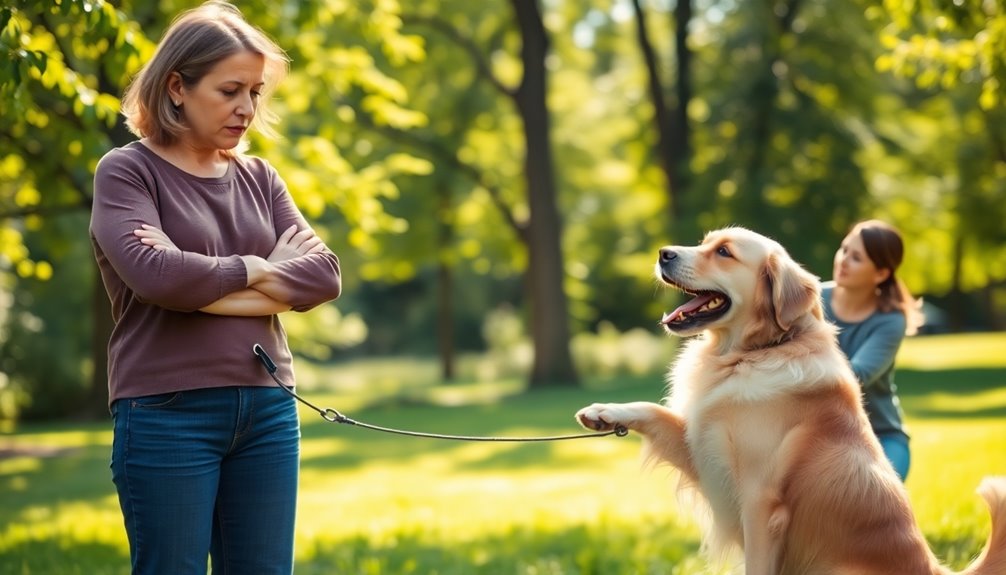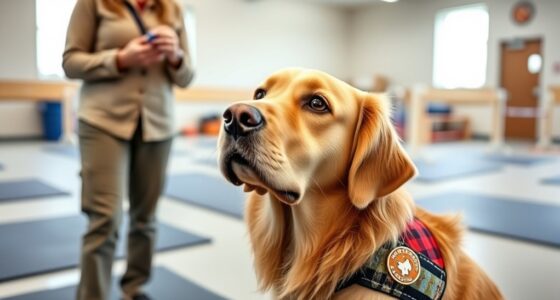To keep your senior dog mentally and physically engaged, focus on gentle, low-impact exercise like walks or swimming to support joint health. Incorporate short, fun training sessions using positive reinforcement and tasty treats to stimulate their mind. Provide mental challenges through simple tricks or puzzles, and create a secure environment that boosts confidence. With patience and love, you’ll find ways to enrich their daily routine—more helpful tips are just ahead.
Key Takeaways
- Use short, positive training sessions with high-value treats to reinforce learning and maintain engagement.
- Incorporate gentle physical exercises like slow walks or swimming to support joint health and boost mood.
- Introduce simple mental challenges such as basic commands or puzzle toys to stimulate cognition.
- Utilize comfortable tools like harnesses and a secure environment to ensure safety and confidence during activities.
- Foster a loving, secure atmosphere through consistent positive interactions to motivate ongoing learning and bonding.

Training senior dogs can be a rewarding experience, even if they’ve been set in their ways for years. As you work with an older dog, you’ll find that patience and understanding are key. One of the first steps to assuring your senior dog is receptive to training is to prioritize their overall health. This means paying close attention to dog nutrition, as a well-balanced diet supports cognitive function and physical vitality. Proper nutrition can help keep their energy levels steady and their minds sharp, making training sessions more effective. It’s also essential to maintain regular veterinary care, which guarantees that any age-related health issues are identified early and managed appropriately. Regular check-ups can help you catch problems like arthritis or vision decline before they interfere with your training efforts.
When you begin training your senior dog, keep in mind that their learning pace might be slower than a puppy’s. Instead of rushing, focus on short, consistent sessions that reinforce positive behaviors. Use high-value treats and praise to motivate them, and be sure to keep sessions fun. Older dogs tend to have a longer attention span when engaged with activities they enjoy, so mixing training with play can enhance their willingness to learn. Remember, older dogs often have ingrained habits, but with patience, you can help them develop new routines or modify old ones.
Physical engagement is just as essential as mental stimulation. Low-impact exercises like gentle walks or swimming can keep their joints healthy and boost their mood. These activities not only promote physical health but also provide opportunities for socialization and mental engagement. Incorporate simple tricks or commands into their routine to challenge their cognition—this supports mental sharpness and can help prevent cognitive decline. As you train, always be attentive to signs of fatigue or discomfort, adjusting your approach accordingly.
Additionally, appropriate training tools such as harnesses or gentle leashes can make walks safer and more comfortable for senior dogs. Consistency and positive reinforcement are your best tools. Your senior dog may not respond as quickly as they once did, but with steady effort, they can still thrive and enjoy meaningful interactions. Combining good dog nutrition and regular veterinary care with tailored training creates an environment where your senior dog feels secure, loved, and motivated to learn. Ultimately, your dedication not only enriches their life but deepens your bond, proving that age is just a number when it comes to growth and companionship.
Frequently Asked Questions
How Can I Tell if My Senior Dog Is Mentally Declining?
You can tell if your senior dog is experiencing cognitive decline by observing behavioral changes like increased confusion, disorientation, or forgetfulness. Look for signs such as difficulty maneuvering familiar spaces or losing interest in activities they once enjoyed. These behavioral changes often indicate cognitive decline. If you notice these signs, consult your vet promptly. Regular check-ups help catch issues early, ensuring your dog stays comfortable and engaged as they age.
Are There Specific Signs of Physical Discomfort During Training?
Ever wonder if your dog feels pain during training? You might notice signs of physical discomfort like stiffness, whining, or reluctance to move, which can be linked to dog arthritis. Watch for training fatigue, where your dog seems unusually tired or distracted. These signs indicate your senior dog may be experiencing pain or discomfort. Always observe closely and consult your vet to guarantee gentle, effective training tailored to their needs.
What Are Safe Toys for Elderly Dogs With Limited Mobility?
You should choose toys for mobility that are soft, lightweight, and easy for your elderly dog to handle, like plush or rubber toys designed for senior dogs. Safe chew options, such as dental chews or soft rubber bones, help prevent discomfort while satisfying their chewing instincts. Avoid small, hard, or noisy toys that might cause frustration or injury, and always supervise playtime to make certain of safety.
How Often Should I Adjust Training Routines for Aging Dogs?
Imagine your aging dog as a fine wine, needing just the right swirl of training frequency to keep its flavor vibrant. You should adjust your routine every few months, listening to your dog’s changing needs and energy levels. Routine adjustments are essential; they prevent boredom and frustration. Stay attentive, and don’t be afraid to slow down or spice things up, ensuring your senior dog remains happy and engaged.
Can Senior Dogs Learn New Commands or Tricks Effectively?
Yes, senior dogs can learn new tricks, but patience is key. Keep training sessions short and positive to combat age-related memory loss. Use consistent commands and plenty of rewards to reinforce learning. While their pace might be slower, your senior dog can still enjoy the mental stimulation of learning new tricks, helping maintain their cognitive function and strengthening your bond. Adapt your approach to suit their changing needs.
Conclusion
As your senior dog gracefully ages, it’s amusing how their stubbornness can outlast even your patience. Despite the gray hairs and slower pace, they still crave mental and physical engagement—proof that age is just a number, not a limit. Ironically, your efforts to keep them active might just remind you of your own need for stimulation. So, cherish these moments; after all, they’re still teaching you a thing or two about resilience and joy.









